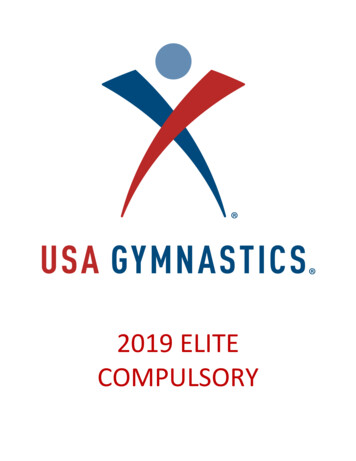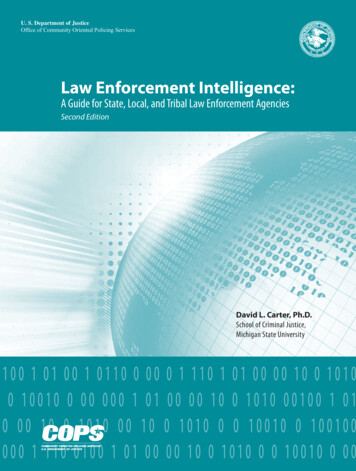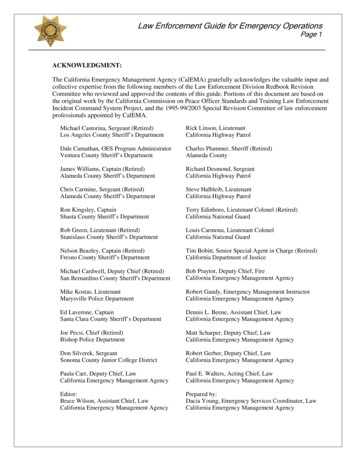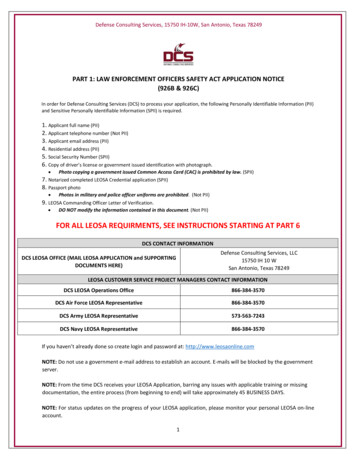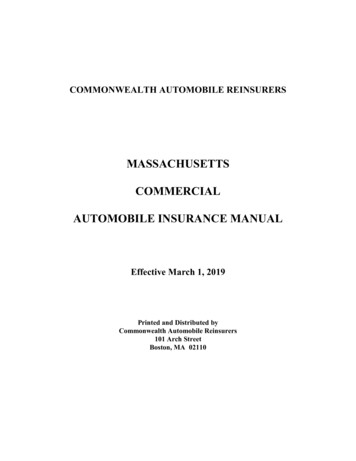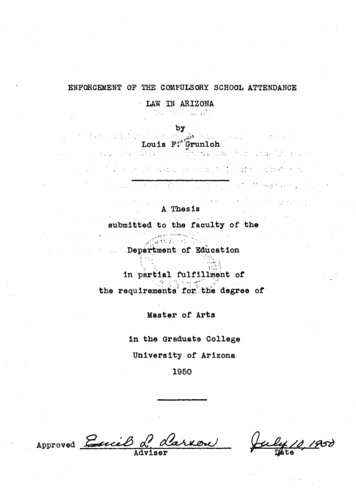
Transcription
ENFORCEMENT OF THE COMPULSORY SCHOOL ATTENDANCELAW IN ARIZONAbyLouis FT' Grunloh 'A Thesissubmitted to the faculty of the'. ." 7". .1*r * *7.; -" Department of Education\ Xv:;yin partial fulfillment of v vT' .,-;Vthe requirements for.-the degree ofMaster of Artsin the Graduate CollegeUniversity of Arizona1950ApprovedC .Adviser
aO::AG;T[ITTA J00HD2 lOiO UiMOO KIT GO TilAZIvADGi-A.AGOGIAA :-;i V-'AJvddcInL’iD VI siL'oleiuerrT Aond 1o v-dl';of4l orld od fcedd'Zino'ysc3?A Go 'XL-d'cn-.fsVd nVtu'»or2riA lo Gvla'ce-vinnQ3G1 aX V- ."eVtiV"0-.\ -X. "V:V; 'W' A- 5-iv - X r V .‘ioaivi'.'AI ) 0 V ‘I-7Cf:X
rm jACKNOWLEDGMENTThe writer wishes to express his gratitude to hisfaculty adviser. Dr. Emil L. Larson, for his constructivecriticism and for his sincere Interest in this study; toDr. 0. K. Garretson, Dean of the College of Education, forhis exacting formulation of the statements in the proposalof this study; and to Dr. Glenn H. Nelson, Professor ofEducation, for many inspiring lectures in the fields ofresearch and education.-v;:1 :v:.' o --/: ;. :, ,, ,i '. i313.926
illTABLE OP CONTENTSChapter: v-PageI. INTRODUCTION . .Historical Bases for State CompulsorySchool Attendance Laws .Relationship of Compulsory School Attendanceand Child Labor Laws . .Origin and Development of Compulsory SchoolAttendance Laws in Arizona . .The Purpose of this S t u d y .The Scope of this Study . .Related Studies .The Plan of Procedure in this Study .II. THE CURRENT STATUS AND THE TRENDS IN THEADMINISTRATION OF COMPULSORY SCHOOL .,ATTENDANCE AND CHILD LABOR LAWS THROUGHOUTTHE UNITED STATES . . .1141025262728'30Source of Data .30Definition of Terms . . . . . . . . . . . . . . . . . . . ;30Discussion of the Several State CompulsorySchool Attendance and Child Labor Laws .31The Extent of the Non-Attendance and ChildLabor Problem in the United States . .59Critique of the Various Enforcement MethodsEmployed . . . . . . . . . . .65Summary .I I I . THE PROBLEM OF NON-ATTENDANCE AND CHILD LABORIN ARIZONA .Source of. D a t a .Definition of Terms .The Extent of Non-Attendance and ChildLabor in A r i z o n a .Geographical, Economic, and Social Factors Involved .Discussion of Methods Presently Employed inthe Enforcement of Compulsory SchoolAttendance and Child Labor Laws in ArizonaS u m m a r y .7577676848690
ivChapterPageIV. REFLECTIONS OF-LOCAL OPINION ON THE PROBLEM93Source of Information93The Gravity of the Problem . .93Effectiveness of Law-Enforcement Methods. Employed . . .98Critique of Suggestions and Recommendations105Summary . . 108V. SUMMARY OF CONCLUSIONS AND RECOMMENDATIONS". 110Conclusions . . . .Extent of Non-Attendance arid Child Laborin the United States .Reasons for the Effectiveness of NonAttendance and'Child Labor Laws in: Several States . . ’ Factors Which Aggravate'and Extend the' Problem in Arizona .Proffered Suggestions from Local * --- * " ' Authorities ;for- Improving the,, .,;. Situation-. . .Re commendations I .More-. Centralized .Supervision, a n d ;”Consolidation of :Authorities’Enforcingthe Non-Attendance and Child Labor Laws 1Institution of a Continuing School Census-’" and ‘More Stringent .Child Accounting :v:j Methods .BIBLIOGRAPHY . .O’-''O'-110110111112113115115117118
VTABLESNumberPageI. THE"DATE OF ENACTMENT OF T H E ,FIRST COMPULSORY ATTENDANCE" LAW IN EACH STATE . . .5II. COMPARISON OF COMPULSORY ATTENDANCE AGES WITHTHE MINIMUM AGE REQUIRED FOR WORK PERMITSAND EXEMPTIONS:RECOGNIZED .:. . . . .9III. AGE FOR COMPULSORY SCHOOL ATTENDANCE FOR FOURDIFFERENT DATES, BY STATES .42IV. AGE FOR FREE ATTENDANCE AT PUBLIC SCHOOLS FORTWO DATES , BY S T A T E S . .43V. PERCENTAGE OF ENROLLMENT IN AVERAGE DAILYATTENDANCE, BY STATE, 1937-1938 .62VI. AVERAGE DAILY ATTENDANCE IN U.S. PUBLIC DAYSCHOOLS AS A PERCENT OF ENROLLMENT FORSPECIFIED YEARS .63VII. LENGTH OF SCHOOL TERM, 1937-1938, 1939-1940,1941-1942, and 1943-1944 .VIII.NUMBER OF DAYS ATTENDED PER PUPIL ENROLLED,1937-1938, 1939-1940, 1941-1942, 1943-1944 .6363IX. SOME CENSUS, ENROLLMENT, AND ATTENDANCESTATISTICS FOR THE PUBLIC SCHOOLS OF THEUNITED STATES, BY STA T E , 1943-1944 . .64X. REASONS FOR AND NUMBER OF WITHDRAWALS FROM THEELEMENTARY SCHOOLS OF ARIZONA, BY COUNTY,1946- 1947 .79XI. REASONS FOR AND NUMBER OF WITHDRAWALS FROM THEELEMENTARY SCHOOLS OF ARIZONA, BY COUNTY,1947- 1948 .79XII. SOURCES AND NUMBER OF RE-ENTRIES INTO THEELEMENTARY SCHOOLS OF ARIZONA, BY COUNTY,1946- 1947 .XIII.SOURCES AND NUMBER OF RE-ENTRIES INTO THEELEMENTARY SCHOOLS OF ARIZONA, BY COUNTY,1947- 1948 .8080
ViNumberPageXIV. ENROLLMENT, FINAL MEMBERSHIP, DAYS IN SESSION,AVERAGE DAILY ATTENDANCE, AND PERCENT OFATTENDANCE FOR TEE-ELEMENTARY SCHOOLS OFARIZONA, BY C O U N T Y 1946-1947 .XV. ENROLLMENT, FINAL MEMBERSHIP, DAYS IN SESSION,AVERAGE DAILY ATTENDANCE, AND PERCENT OF-; ATTENDANCE"FOR THE ELEMENTARY SCHOOLS OF' : ARIZONA, BY COUNTY, 1947-1948 .81o-:: t - Jlo:,' .’ :u :3 :1:T i- c m .V-V. : i d81
a c. -:i;."'i:dred 'L .v I;.'in Kr x- t.;:vT.r3 XMi'r v :/'-/C1.:.J c r.: 1 : l v: e e -:cCHAPTER I x.: l.r.XX"r-.'vr-; .-rIHTRODUCTIOHHlatoricaT Bases for State Compulsory SchoolAttendance Laws-drv':' e . ::;vv':::or- i-rd--:.-vLaws on compulsory school attendance are how found InJ/:' rv;-.-: .:e’r.eio : ' jv-x-"r r--all of the United States.This situation has developed In;. - ' v K X - ' - . ' L - y x y ' ;' . spite of great resistance from many sources.Compulsoryj r r d x : .::vex-triex.x ;; -:attendance represents a field in which social economy andVi'Inherited traditions as well as selfishness clash. BecauserLX- : ,Lx:X X!X L'.' di.i;-.r. , ; . ; X ' . % - . % - . .-of t h i s , progress has been slow and legislation often has ' v;'" - X- xrx, , :d'-X 0r-::;,X / X.- ; x- . I,. .so far outrun public opinion that the laws have remainedquite unenforcedV*r ;.:, . : ;;After the battle for free public schools had been wonand a state system of schools had been established that v.-x x:V s , , --xx--: : , -r.- -x ,r,.guaranteed as a heritage to every child the opportunity fora common school education, the advocates of universal educa'' : x-:-x;:x ,x ' x-:::X: X:'xxx:'X x:X; . -x- -!xX-tion soon found themselves engaged In another battle, the"dxx*.X X' x ‘ :, ;xx;r:x ,xx'xxXX":-x L-L; -.battle to realize fully the purpose for which free public.*e‘t ' xl '1 X vschools were established; namely, the development of anX XXx x - : Xx ' tXX--X . .XX :' " x- x ' . ;'-.,.intelligent citizenry as a basis for our democratic f o r m *X'l x :'0 AxU\ :v Xof government.t-.f,; ,X'l ; x x x ; L L x ; -. ;i.xThe individual states soon realized that itvv J .was one thing to provide by law tax-supported schools forall children within their: jurisdiction, but quite anotherthing to get all children privileged to attend school totake advantage of such opportunity.When persuasion failed
2to secure the desired attendance, the citizens of the variousstates began to look to the state, as they had in the battlefor free schools, for the establishment of'legal compulsionsthat would correct this shortcoming bn the part of a minorityof the people.;: : ;“ 1 -"' In the battle for compulsory school attendance, the aidof the state,was invoked for the reason that local schoolsystems could.not cope with the situation.They could notexert, sufficient authority or pressure individually and inde pendently to secure the desired attendance i n their respectivejurisdictions; nor could-they collectively, through jointaction, force children into school on a state-wide basis.Asa consequence, state legislatures prescribed legal regulationsfor compelling school attendance.Thus the authority for r e quiring the attendance of children at-school was establishedas a.state prerogative A:.:-; :rThe state, undoubtedly, has authority over the educationof its citizens, for the manifest reason that a good educationis necessary to the common welfare, which is the purpose ofthe state's existence and the ground of all its authority.The successful transmission of the cultural inheritance ofmankind from one generation to another is as much a necessityto the large organized group, the state, as it is to eachindividual human being.T1.'1Proffitt, Maris M. and Segel, David.School Census-Compulsory Education— Child Labor--State Laws andRegulations"Bulletin 1945, No. 1, TJ.S. Office ofEducation, p. 4.— .
3' iThafc is a truth h ey ond- dis put e .But it he ;pr a ct i eal -ques -tion,- not always so clearly anawered is t h i s :H o w .is thestate"to exercise its authority over the education of i t s :cit izena ? 1The oorre ct ’answer to that question must be based 2.upon the essential fact that:thefstate existsifor the benefitof those who are its members that:its character is dependent,not absolute that it must respect1and promote the naturalrights,and dignity of its citizens, not ignore o n usurp thosarights; 'I t :cannot,:therefore,: take away from each member, ofthe state his Inherent right and duty to educate h i m s e l f vItcannot take away;from .parents their primary right and duty tohelp-their children to educate themselves.It must safeguardthe common good in education by using its police power to enforce upon individuals' and upon parents the fulfillment oftheir duties in education. Its authority lies in that powerof insisting.that individual;citizens comply with their naturalobligations’ in education,; and! of supplying moral and;materialhelps to meet the deficiencies of parents and children i ncarrying out their duty. :That constitutes the state an-agencyin education,-working through others, rightfully concerned ;w i t h educational procedure, not; as its own Immediate task,but as a duty.of its:citizens;to which;the state:lends itssupport. or : \r.: :-y v.;''. ;: :.;v‘ c;-n Governmental .control: of; s dhool: attendance-had.its in ception in the Massachusetts laws of the seventeenth century;:. 'C:!::ivu;: ;-rt2 ,Kane, W . , S.J. rtSome Principles of Education.H LoyolaUniversity Press, Chicago, Illinois, 1938, pp. 145-146.„
4and these principles remained to become the foundation ofpresent-day- state compulsory school attendance la w s .%Massachusetts had become the recognized leader in educationin the sisterhood of states and the fact that she had enacteda law requiring the attendance of all her children in theestablished schools exerted a powerful influence upon legislation in the: younger states. : In these latter states, fortunately, the actual, operation of the law in Massachusetts wasnot critically examined-, the principle only receiving attention.This is Illustrated "in t h e :compulsory school attendance lawsof Michigan'(1871), Kansas (1874), Ohio (1877), and Wisconsin(1879).s:;-r.:Relationship of Compulsory School Attendanceand Child Labor Laws;Since Massachusetts passed the first compulsory attend ance act i n ,1852 there has b e e n .a great .change,in the characterof this legislation.(Table I shows-the date of enactment ofthe first compulsory attendance law in each state/)The pro-gressive amendments by which these laws have been enlarged andstrengthened reflect to a large extent the economic and social, '* *«**' ’ : ;« 4development of the; Individual states. ( *-i-*- »j'.4*These laws have grownnot only because of the desire of the people to furnishgreater opportunity for the children but because the stateeconomy m a d e it possible to do so and the employment of3.Ensign, Forest C h e s t e r . " C o m p u l s o r y School Attendanceand Child Labor." The Athens Pre s s , Iowa City, Iowa,1921, p . 53.
TABLE Iv!;J.)y -i»v/i:\.1 "tV: i'-y:(,.tV:THE DATE OP ENACTMENT OP THE FIRST C(MPULSORY ATTENDANCE Z.vl a w .i n 'e a c h s t a t e": ”; .j --I .'v '.i'v '*: Massachusetts . 1 ,1852District of Columbia .; ,1864Vermont . . .1867New Hampshire . i ] 1871Michigan1871Washington .; 1871Connecticut . 1872N e v a d a .'1873New Y o r k . . .1874Kansas I . . . . . . . . . . . . . . . . ; . . . 1874California .1874Maine .1875New Jersey . 1875W y o m i n g . 1876Ohio' .;. 1877Wisconsin . . . 1879Rhode Island . 1883Illinois .1883North Dakota . . . . . . . . . . . . . 1883South Dakota .1883Montana . . . . . . . . . . . . . . . . . . . . . . 1 8 8 3Minnesota L". ' 1885( Nebraska1887Idaho . 1887Colorado . . . *. ; 1889Oregon .;.'. . 1889Utah . * . . . .;. a. 1890New Mexico- .U. 1891,Pennsylvania -.;. 1895 'Kentucky .'. 1896. West Virginia1897. ;Indiana, . . . . . . ; . . . . . . . . . . . . 1897A r i z o n a . .1899Iowa . . . . . . . . . . . .1902:Maryland . 1902Missouri .;.'.:. . . 1905-rTennessee .v . . . 1905 Delaware . ;. . ’. 1907North Carolina. .;. 1907Oklahoma. 'y. 1907,Virginia .'. y.,. 1908"Arkansas . . . 1909'Louisiana . . . . . . . . . . . . . . . . . . 1910Alabama . . . v .;. 1915Florida . Y . .;.;. .y. 1915 South Carolina . .-. .1915Texas. i. 1915Georgia. . 1916Mississippi. . . . . . . . 1918.; '' Compiled from Compulsory School Attendance Laws of the United States,? Bulletin1935, no. 4, p. 8. Washington:Government Printing Office,. 1935.
6Immature youth was an Immediate economic threat to:the adultworker. : ;The growth cof;compulsory attendance claws cannot be disassociated from the .child labor movement. .vb r. : rbi.The forces back:of;the Massachusetts L a w :of 1852 appearto h a v e :been political, including the Influence of organizedl a b o r a n d philanthropic, rather .than educational. HoraceMann, the Secretary of the Massachusetts State Board ofEducation at that t i m e ,3had convinced the press a n d :doubt less the political andisocialLleaders of the evils of nonattendance, but he had not asked that all children be forcedinto school:by law.It does not appear that anything soradical was-contemplated by the State Board of Education northe local school icommittees, while there is reason to believethat teachers regarded the Influx of unwilling children wi t hdistinct disfavor.4-‘,No matter under what disguise the initial attendancelaws entered upon the statute books of the several states,industrial exploitation was the principal cause of thecampaign for child protection through education.The divisionof labor under the factory system, the u s e of machinery, andthe wage system had made possible the use of children in waysso destructive of their physical/.moral, and intellectualwell-being that protective measures were demanded of-society.It is obvious / therefore, that laws "to 'prevent *childrenfrom working and laws to secure their attendance at schoolare answers to two sides of the same question, namely; child4%Ensign, Forest Chester,op. clt. . p. 55.
7welfare. -Child labor laws and compulsory education laws hadtheir origins'in a common problem and to:a-considerable ex tent grew up together, especially since;the:factory period.If the question was raised that employment endangered thephysical welfare of the child, it found Its counterpart inthe statement that the consequences of beingiout:of s ohoo1endangered-the:educational welfare of the child.;-Frequentlyarid; enactment of a legal provision governing child.labor wasaccompanied-or soon followed by a legal provision for compul sory school attendance, and vice versa.In facty in .t h e :earlier period of the development of child welfare laws, .legalized employment and legal; educational:compulsions wereoften.two provisions in the same statute.For example,statutory provisions for: indentured apprenticeship dealt; owith both employment!and the education;of, the apprentice, aswell as with other provisions for his welfare,. such as hiscare and support.V: : ;'n;v-;.,H e n c e , as -the age for compulsory education has moved u pand the enforcement of attendance laws;has become fairlygeneral, the relation of schooling,to child labor has assumedconsiderable Importance.or on some job.A child has to be either, in schoolMuch.work is sometimes necessary, to bringthe child into adjustment with: either .one:of these environ-r.ments.Education has the prime responsibility to see thatpupils are either in school or at.work, whereas the labor .or welfare departments have prime responsibility to see thatthe conditions of work are.suitable,for youth.There is,however, considerable overlapping in these responsibilities.
8Also, the problems with which compulsory attendance andchild labor laws are concerned, especially those phases ofthe laws relating to exemptions from their operation, showvarious and wide relationships with general welfare problems.(Table II shows a comparison of compulsory attendance ageswith the minimum age required for work permits and exemptionsrecognized.)For example, the mental and physical conditionof the child, the age at which he may leave school, and theage at which he may go to work, seasonal demand for labor,the kind of labor in which a child may engage, the schoolgrade completed, and the distance he resides from school areall tied in with provisions for the general welfare of thechild.Under present administrative arrangements, the enforce ment of child-labor laws insofar as they pertain to hours oflabor, conditions of labor, and types of work is generallyin the hands of the labor or welfare department of the state.The schools usually cooperate with the labor department inchecking on the violations of the compulsory school lawthrough the employment of children.The law usually directsthe attendance officers to make complaints and prosecute caseswhere the compulsory school law is concerned.Violations ofthe labor laws not concerned with violation of the compulsoryschool law are invariably a responsibility of the labor orwelfare departments of the states.Both school representa tives and labor department representatives usually have thepower to Inspect factories, offices, and other places where
Age of Compulsory " 'Exemptions to CompulsoryAttendance Education Laws tanaNebraskaNevadaNew HampshireNew JerseyNew MexicoNew YorkNorth CarolinaNorth DakotaOhioOklahomaOregonPennsylvaniaRhode IslandSouth CarolinaSouth est VirginiaWisconsinWyoming67181881871786].7716816X X .716 X78151414XXXXXX XXXXX *XXXXXX.XXeX X#eX XXX XXIndefinite.X. anceX X. .Povertye.XXXXX .X. X.XX XX XXXX X XX XXXXXXMinimumMinimumAgeforWorkPer-Education8-Gr -Gr.8-Gr.6-Gr.8-Gr.8-Gr.6 Gr.6-Gr.8 14141414Exemptions to ChildLabor Laws Recognized"Agri- Docul- XXXeeXXX.eXXXXXXXXXXXXXXXXXXXx,XXe.XCompiled from "Compulsory School Attendance Laws and Their Administration," pp. 103, 15-16. United States Department of th*Interior. Washington:Government Printing Office, 1935coverly Coleman, "Digest of Child Labor Laws of the States," pp. 1-3.23. Washington: National Recovery AdministrationMarch, 1936.
10children, might be employed and to examine the employmentrolls .: : --' :---T h u s e v e n though the forces backing compulsory educa tion have always been too much tainted by political, economicaland philanthropic, rather than educational, interests, the,present legislative and administrative trends are encouraging.The initial influences brought:about the enactment of lawswith high public relations value, but with little or no prac tical implications for education.In our current efforts inthis afield w e :need to bring the latter up to a par with theformer.The continued close;relationship of compulsoryattendance and child labor laws will then have a most salutaryeffect.:.1v.:.v:Origin and Development of Compulsory SchoolAttendance, Laws in ArizonaArizona, even at its;earliest inception as a territory,;was fortunate to have an administration which was conscious of the importance.of a system of common schools in any demo cratic state.In a message to the First Territorial Legisla ture ;on September 50, 1864, Governor Goodwin solemnly advisedthe lawmakers as follows:Mv . . O n e of the most interesting and Important subjectsthat will engage your attention is the establishment:of asystem of common schools., . .r; .'.:"Self-government and universal education are inseparable.The one can be exercised only as the other Is enjoyed.Thecommon school, the high-school, and the university should be
11established, and are worthy o f your fostering care;The:firstduty of the legislatures ofia free state is to make; as far aslies in.their power, education as free to all its citizens asthe air they breathe;A system of common schools is the-grandfoundation upon which the whole superstructure should rest.Ifcthat be broad and firm, a symmetrical and-elegant templeof learning will be erected.I ;earnestly recommend that aproportion of the funds raised by taxation be appropriatedfor these purposes vIn-his very eloquent m a n n e r , Governor aoodwihrthereby:laid the foundation for compulsory education in the ArizonaTerritory.Since compulsory school attendance laws are basedon the provision of a system of tax-supported, common schoolsthroughout the governmental u n i t , the first step in thatdirection had been taken.The members of the First Territorial Legislature indicated,by the Ir serious react ion to the Governor1s m e s s a g e t h a t theyunderstood the importance of the problem before them.On October 27, 1864, Mr. Hopki n s , chairman of the Joint Committeeon Education of the First Territorial Legislature, made thd :following report; ' '';1 - - "v -i::i: - "The Joint Committee -on Education r e p o r t , that after amature consideration, they have decided that it would be pre mature to establish, or to attempt any regular system of commonor district schools.' - 1 --5% -At present the Territory'is too sparsely- ' 1- -. J- . . ---V,Farish, Thomas Edwin. History of Arizona. The Fllmer .Brothers Electrotype Company, San Francisco, California,1916, vol. 5, pp. 104-105.
12settled, and the necessary officers for such an establishmentwould be more costly than the educatIon of the children wouldwarrant. "T -n;v ;.'.,v' .h ":y.y"In lieu of such system, and for a foundation of Territorial;Schools your committee earnestly recommend that anappropriation be made and given t o these tow n s , where thenumber of children warrant the establishment of schools."At the Mission of San Xavier del Bac, Padre Messayah a s , at great trouble and expense to himself, educated allchildren .free of charge ,v His pupils are Mexican and Papago;he has been sadly impeded in his efforts by want of suitable-S chool books.",.f : .* - it "A.donation, *.as suggested by his Excellency, the Governor,in his late message, would be but a fitting compliment to thefirst school opened in Arizona.:."In Tucson there were three primary schools during partof last y e a r .- There arelover:two hundred children in this ntown that should be attending school.of the above;class. :At La?as.there was one:"Your committee recommend that a. donation be made to theMission School at San Xavier„del Bac. of 250.To Prescott,M o h a v e , and L a P a z , each town 2 5 0 . , To Tucson 500, providedthe* English language forms a part, of the instruction of eachschool.: V.,-.;- :"The above appropriations to towns to be null and void,unless said towns, by taxation or individual enterprise,furnish an equal sum to the support of such public school." 6 ]Parish, Thomas Edwin,op. cit., pp. 123-124.
15The above recommendations were soon after enacted intolaw with the specific restrictions as suggested by the Com mittee .The county commissioners, by that law, were made thetrustees of the public schools arid had the power to appoint asuitable person to examine the course of- instruct ion, 'disci— 1pline, and attendance of said schools, and the qualificationsof the teachers, and to report- the same to them at their statedquarterly' meetings.7-. -i;. ::v"\c".- /; ;' T h u s , the First Territorial Legislature established- theprinciple of state supported and state controlled common schools.It also indicet ed the necessity for governmentalsubdivisions to contribute to the support of1their own schoolsystems.Furthermore, it implied that the matter of attendanceat Such schools was worthy of the attention of the highestadministrative officers then available. v ,Because of the lack of properly trained teachers and theunavailability of suitable buildings, very little developmentof a public school system took place until 1871.During thatyear, the Arizona Legislature enacted a law which had in v i e w ‘the establishment of'free public schools in the Territory.This gave an impetus to the growth1of the school organizationand, b h May 16', 18*74,' the Arizona Citizen noted that K. Van-Alstine (the district school marshal) had completed the Schoolcensus of the Tucson District, which was required by law to betaken in May of each year by an appointed school marshal.7*1Parish, Thomas Edwin,op. clt. . pp. 155-156:
14.The Arizona School Law,1which was published In 1879,Includes "An Act. Relating to. Compulsory Education," which hadbeen approved pn.February: 9, 1875.i- Thls:, apparently, Is the:Initial legislation-on this matter and It Includes most:of the ;provisIons.that are part of our current l a w .reads as folt:)}-. "Section 1.lows:v.%-‘hoc:The Act of 1875bEvery, parent, guardian,; or other person inthe Territory of Arizona, having .control-; and charge of a childor children between;the., ages; of eight;and fourteen years ,t shallbe required to .send such child orichildren to a public school;for a period of at least sixteen weeks,; in each school ye a r atleast eight weeks of which shall b e ;consecutive, unless suchchild or children are exempted from such attendance by the boardof school trustees, of the. school district in which .such parentsor guardians reside, upon.its being shown to;their satisfaction;that the bodily or mental condition-of;such child or ;childrenhas been s u c h as. to prevent h i s , her or their attendance at school, or application to.study, for the period required, or.that such child or children are -taught in a- private school,-orat.,.home, in such branches as are. usuallyrtaught in a primaryschool, or have already acquired .the ordinary, branches of .learningtaught in the public.,school; provided, in case a public schoolshall not be taught, for .the period of sixteen w e e k s , o r a n ypart thereof, during the year, within two m i l e s ; by the nearesttraveled road, of the residence of any person within the schooldistrict; or if not sufficient eccoumodations for all the childrenare provided for within the school district,»he or she shall
15not be iliable to :the provisions oof this A c t .v: Section 21j.yIt shall be the duty of the board of: schooltrustees of each: s chool! district in: this Territory j on o r ’be-;,fore the first Monday of September in each year, to furnish theteacher of each public school taught in such district with a ylist of all children residing in the school district, betweenthe ages of eight and fourteen years, - said list to be takenfrom the report of the school census marshal;At the;beginningof each school month thereafter it shall be the duty:of the yteacher in each school in such district, to report to the boardof school trustees of such district the names of all childrenattending school during the previous school month; w h e n / if itshall appear, at,the expiration1of four.school m o n t h s , to theboard of school trustees, that any parent, guardian or other:person having charge.or control of any child or children, shallhave failed to comply with the;provisions of this Act, theboard shall cause demand to.be made upon such parent, guardianor other person for the amount of the penalty, hereinafter pro- .vided; w h e n , if such parent,. guardian or other person shallneglect or refuse to pay the' same within.five days, after themaking of said demand, the. board shall.commenc
iii. age for compulsory school attendance for four different dates, by states . 42 iv. age for free attendance at public schools for two dates , by states. 43 v. percentage of enrollment in average daily attendance, by state, 1937-1938 . 62 vi. average daily attendance in u.s. public day



